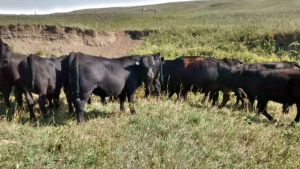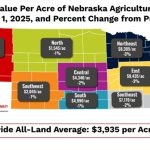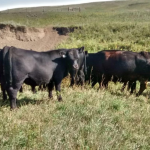Playing God: Ward County, North Dakota ceases cloud seeding for the year, debate continues in Bowman County
for Tri-State Livestock News

A weather modification program, also known as cloud seeding, in North Dakota has residents questioning not only the value of the program, but also the science behind a procedure that some think does more harm than good.
The heated debate in Ward County got some temporary closure when the Ward County Commission voted 4-0 to end the controversial cloud seeding for the rest of the year.
Roger Neshem, who serves by appointment on the county’s weather modification authority said ending the project makes sense.
“We are asking to join the other 47 counties in the state who do not try to modify their weather,” Neshem said. Ward County, home to Minot, is one of seven left in a seeding program in the state. The others are Bowman, Burke, McKenzie, Mountrail, Williams and part of Slope.
“There is no way to know. You do not know what would have happened if [the cloud] wasn’t seeded.” Roger Neshem, Ward County weather modification authority
Neshem said there is simply not enough proof that it works, and financially, it is a burden. Plus, some residents believe the seeding is actually aggravating the drought conditions.
“My wettest years are the years they aren’t working,” Neshem said.
Cloud seeding, or weather modification, is believed to change the amount or type of precipitation that falls from clouds, by dispersing chemicals into the air that serve as cloud condensation or ice nuclei, which alter the microphysical processes within the cloud.
Opponents argue that seeding actually diverts rainfall away from drought-stricken pastures, and says that the program has done nothing for crop insurance rates relating to hail damage. According to Neshem, Ward County rates are actually higher than most by as much as 20 to 30 percent, which he says leads to the argument that hail reduction has not been successful.
“The number one study out there is hail insurance premiums. It hails here more than anywhere, still,” he said.
The recent heated board meeting, filled with cloud-seeding opponents, left more questions than answers.
“You watch the planes seed, you will see storms weaken.” Neshem said in a KX News interview.
“Ward County has been in the weather modification project for an excess of 38 years I believe it is. We have always been sold the program on lower hail rates, increased rainfall.”
Neshem believes that a true scientific experiment on the value of seeding would require 38 years of no seeding.
Tim Brown, a producer on the South Dakota side, in Harding County agrees.
“My personal opinion on it, I think they should let Mother Nature take its course,” Brown said. “We are quite positive [the planes] do break clouds up.”
Whether it’s the plane flying through, or the chemicals, Brown said they’ve actually seen it happen. Harding County has no vote in the process, Brown pointed out.
“I just don’t see the benefit of it. On these dry years, I’d rather take the risk,” he added.
John Palczewski, a farmer and rancher from Scranton, North Dakota, in southeast Bowman County is just down wind from where the seeding starts. Palczewski says that the planes, mostly piloted by interns, are used to control the weather, and that is a violation of his private property rights.
“I can visually watch it from my house,” he said. “You can watch the clouds build. You can see the planes and watch them seeding. Then they’ll (the clouds) just disappear.”
But the county’s Weather Modification Board has different plans. The board, appointed by the commission is in charge of the flights that deliver chemicals to clouds to reduce hail and promote rain.
Darin Langerud, director of the board, believes it works and isn’t grounding the planes without a fight. Langerud told commissioners that only the commission appointed board has the authority to suspend the program.
Supporters, including Bowman County Commissioner, Pine Abrahamson, say the program works.
“This year, it is a challenge to grow a crop, but this year looks like gravy compared to 88,” Abrahamson said, adding that weather patterns are not always in cloud seeding favor. “If ever cloud was the same, you could really treat it.”
Lack of clouds in general, makes it hard to seed. But according to Abrahamson, while it may be difficult to quantify, the hail suppression has been successful.
“You can not eliminate hail, but you can reduce it,” he added.
Neshem, whose grandfather was a pioneer of the seeding program, is not throwing in the towel anytime soon.
“He also fought to end it,” Neshem said, referring to his grandfather. “If someone showed up in your yard and said we can make it rain more and hail less, you’d buy into it to.”
Last year, Ward County commissioners eliminated funding for the weather modification program for 2017. The decision would have cut $190,000, or .55 mills from the budget, according to reports, but the commission later reversed its decision.
“The burden shouldn’t be on me to prove that I’m right; the burden should be on them to prove that [the program] is working,” Neshem concluded.
And that is the difficult part.
Research
Can cloud seeding — dispersing particles into the air with the aim of increasing precipitation – increase or decrease moisture? A number of old and new studies lean toward yes, and according to reports, there are over 50 countries participating in some version of cloud seeding.
According to the Atmospheric Resource Board’s website, and a 2008 study, cloud seeding suppresses hail, citing research of a reduction in crop-hail damage by 45 percent. Independent research studies also claim an increase in rainfall from 4 to 14 percent, with cloud seeding.
The 2008 study, conducted by Dean Bangsund and Dr. F. Larry Leistritz, of the NDSU Department of Agribusiness and Applied Economics, shows the North Dakota Cloud Modification Project (NDCMP) is strongly economic, even when considered on its most conservative results.
Rainfall enhancement benefits for the program were evaluated at two intervals (5 and 10 percent), which reflect the long-term evaluations of the NDCMP. In the 5 percent scenario, the value of increased crop production is estimated to yield $8.4 million annually, which equates to $3.58 per planted acre. In the 10 percent scenario, the value of increased production is estimated to yield $16 million annually, or $6.84 per planted acre.
The analysis of hail suppression activities shows the average crop value saved through cloud seeding is $3.7 million per year, which equates to $1.57 per planted acre. Including hail suppression benefits, the total direct impact in the 5 percent rainfall scenario is $12 million annually, while the total direct impact in the 10 percent scenario is $19.7 million. That translates to $5.16 and $8.41 per planted acre, respectively. These results yield a benefit-to-cost ratio, based on anticipated 2009 project costs, of 16 to 1 for the 5 percent scenario, and 26 to 1 under the 10 percent scenario.
Skeptics still have a point relating to studies. Running control experiments in cloud-seeding studies is a challenge, and statistically, results in no proof. With over 70 years of testing, the answers are still hard to come by.
“There is no way to know. You do not know what would have happened if [the cloud] wasn’t seeded,” Neshem points out.
Early studies of the process died off after the 1980s, but new technology and new work in the sciences has researchers looking for new science based answers.
A more recent cloud-seeding project in southwestern Idaho, aimed at increasing snowfall, funded by the National Science Foundation (NSF), looked at increasing snow pack late last winter.
“I was surprised at the characteristics of the clouds in Idaho,” says Jeff French, a University of Wyoming (UW) atmospheric scientist and principal investigator of the project, called SNOWIE (Seeded and Natural Orographic Wintertime Clouds – the Idaho Experiment). “The air was surprisingly clean, and the clouds had very low concentrations of liquid drops.”
Those conditions affect which processes in clouds are important, how many droplets there are, how big they are, and ultimately how much snow falls, French says. This winter in Idaho, that was a lot.
UW researchers used the NSF-funded King Air research aircraft to conduct the cloud-seeding project from January 7 to March 16.
The project also included scientists from the University of Colorado Boulder, University of Illinois at Urbana-Champaign, Boise State University, the National Center for Atmospheric Research (NCAR) and the Center for Severe Weather Research.
Due to water shortages and droughts in some states and countries around the world, cloud seeding is seen as a potential way of increasing water supplies for communities and of irrigating crops. Water resource managers, hydropower companies and agricultural organizations typically pay for the process.
During SNOWIE, French says that the King Air operated in 24 intensive observation periods that each lasted from 4-8 hours. During those periods, researchers collected measurements in both seeded and unseeded clouds over a range of atmospheric conditions.
An NSF-supported Doppler on Wheels (DOW) fleet of radar dishes mounted on the backs of trucks was also involved.
“SNOWIE was very well-timed, happening during the snowiest winter in Idaho in decades,” says scientist Josh Wurman, director of the Center for Severe Weather Research, which manages the DOWs. Wuman said the DOWs ended up marooned on the mountain until runoff, because of the amount of snowfall.
During the last week of the experiment, French says, the team had to cease cloud-seeding operations as a result of the heavy snow. Idaho Power’s policies require that cloud-seeding be suspended, due to potential flooding concerns, when an area exceeds 140 percent of maximum normal snowpack on the ground.
In 2015, the 6-year, Wyoming Weather Modification Pilot Project (WWMPP) concluded, with the most comprehensive and rigorous whether study to date, but still, for the most part, came up inconclusive. The $14 million project, with more than 150 tests, did indicate that seeding elevated snowfall.
“The accumulation of evidence from statistical, physical, and modeling analysis suggests that cloud seeding is a viable technology to augment existing water supplies, for the Medicine Bow and Sierra Madre Ranges. While the primary statistical analysis did not show a significant impact of seeding, statistical analysis stratified by generator hours showed increases of 3-17 percent for seeded storms,” the scientists concluded. For more information on North Dakota’s cloud seeding program, visit, http://www.swc.nd.gov/arb/ndcmp/pdfs/q_a.pdf



